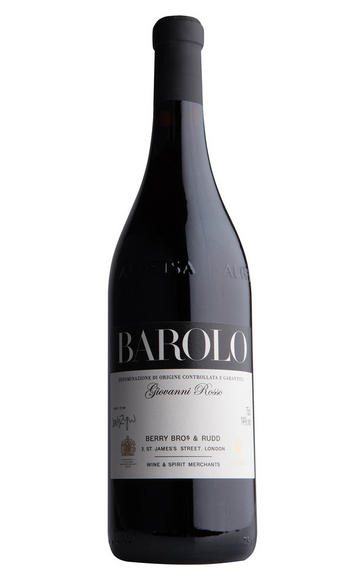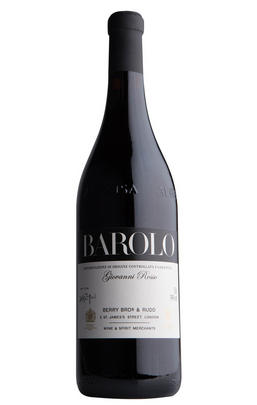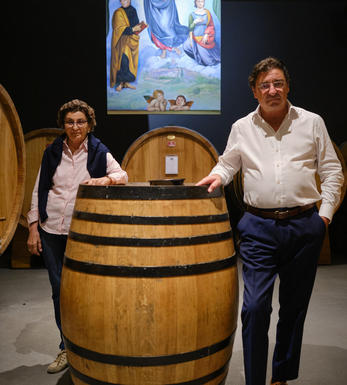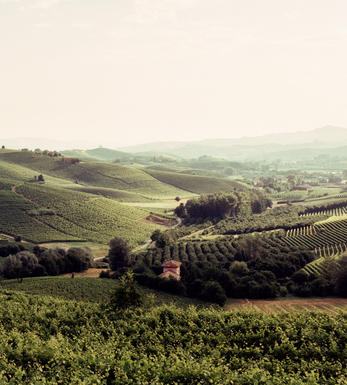
2015 Berry Bros. & Rudd Barolo by Giovanni Rosso, Piedmont, Italy

Critics reviews
Victoria Moore, The Daily Telegraph
Italia! Magazine
About this WINE

Giovanni Rosso
Davide Rosso took over from his father, Giovanni, in the early 2000s. He has since risen quickly in reputation as one of Piedmont’s greatest producers. He may not have the uninterrupted winemaking history of some of his famous neighbours, but he is the envy of many: he has some of the most desirable vineyards in Barolo – Serralunga d’Alba, Cerretta, Serra – showcasing the vivid terroir of his beloved hometown.
His range of single vineyards demonstrates his sensitivity and skill, and his pride for his hometown only magnifies the details of these crus, resulting in wines of rare class and sophistication.
Using traditional cement for fermentation with long gentle macerations, Davide’s wines are timeless, traditional and expertly crafted. His specially made French botti from the Fontainebleau forest are an indicator of Davide’s refined flamboyance. And his vineyards give him the quality of raw material to demonstrate his charm and flair.
He also crafts a small amount of wine in neighbouring Langhe and Roero and an Etna Bianco and Etna Rosso from stunning volcanic sites in Sicily.

Barolo
Located due south of Alba and the River Tanaro, Barolo is Piedmont's most famous wine DOCG (Denominazione di Origine Controllata e Garantita), renowned for producing Italy's finest red wines from 100 percent Nebbiolo.
Its red wines were originally sweet, but in 1840 the then extant Italian monarchy, the House of Savoy, ordered them to be altered to a dry style. This project was realised by French oenologist Louis Oudart, whose experience with Pinot Noir had convinced him of Nebbiolo's potential. The Barolo appellation was formalised in 1966 at around 1,700 hectares – only a tenth of the size of Burgundy, but almost three times as big as neighbouring Barbaresco.
Upgraded to DOCG status in 1980, Barolo comprises two distinct soil types: the first is a Tortonian sandy marl that produces a more feminine style of wine and can be found in the villages of Barolo, La Morra, Cherasco, Verduno, Novello, Roddi and parts of Castiglione Falletto. The second is the older Helvetian sandstone clay that bestows the wines with a more muscular style. This can be found in Monforte d'Alba, Serralunga d'Alba, Diano d'Alba, Grinzane Cavour and the other parts of Castiglione Falletto. Made today from the Nebbiolo clones Lampia, Michet and Rosé, Barolo has an exceptional terroir with almost every village perched on its own hill. The climate is continental, with an extended summer and autumn enabling the fickle Nebbiolo to achieve perfect ripeness.
Inspired by the success of modernists such as Elio Altare, there has been pressure in recent years to reduce the ageing requirements for Barolo; this has mostly been driven by new producers to the region, often with no Piedmontese viticultural heritage and armed with their roto-fermenters and barriques, intent on making a fruitier, more modern style of wine.
This modern style arguably appeals more to the important American market and its scribes, but the traditionalists continue to argue in favour of making Barolo in the classic way. They make the wine in a mix of epoxy-lined cement or stainless-steel cuves, followed by extended ageing in 25-hectoliter Slavonian botte (barrels) to gently soften and integrate the tannins. However, even amongst the traditionalists there has been a move, since the mid-1990s, towards using physiologically (rather than polyphenolically) riper fruit, aided by global warming. Both modernist and traditional schools can produce exceptional or disappointing wines.
Recommended traditionalist producers:
Giacomo Borgogno, Giacomo Conterno, Bruno Giacosa, Elio Grasso, Marcarini, Bartolo Mascarello and Giuseppe Mascarello.
Recommended nmdernist producers:
Azelia, Aldo Conterno, Luciano Sandrone, Paolo Scavino and Roberto Voerzio

Nebbiolo
Nebbiolo is the grape behind the Barolo and Barbaresco wines and is hardly ever seen outside the confines of Piedmont. It takes its name from "nebbia" which is Italian for fog, a frequent phenomenon in the region.
A notoriously pernickety grape, it requires sheltered south-facing sites and performs best on the well-drained calcareous marls to the north and south of Alba in the DOCG zones of Barbaresco and Barolo.
Langhe Nebbiolo is effectively the ‘second wine’ of Piedmont’s great Barolo & Barbarescos. This DOC is the only way Langhe producers can declassify their Barolo or Barbaresco fruit or wines to make an early-drinking style. Unlike Nebbiolo d’Alba, Langhe Nebbiolo can be cut with 15% other red indigenous varieties, such as Barbera or Dolcetto.
Nebbiolo flowers early and ripens late, so a long hang time, producing high levels of sugar, acidity and tannins; the challenge being to harvest the fruit with these three elements ripe and in balance. The best Barolos and Barbarescos are perfumed with aromas of tar, rose, mint, chocolate, liquorice and truffles. They age brilliantly and the very best need ten years to show at their best.


Buying options
Add to wishlist
Description
Made for us by Davide Rosso, our Barolo is a traditional blend of vineyards from different villages. The 2015 displays all the hallmarks of the sunny, charming vintage. Aromas of black cherry, violet and dried herbs lead to a seductive palate, layered with rich cassis, cherry and savoury spice. The opulent texture and fine tannins are balanced beautifully by refreshing acidity.
Drink now to 2034.
Matt Smith, Wine Buyer, Berry Bros. & Rudd
I recently enjoyed this Barolo in the pre-lockdown company of some very good friends. The agenda for the day was a simple one: visit my old Exeter University housemates (newlyweds; now Mr. & Mrs. Smith), watch the rugby, grill some food and enjoy some wine.
The rugby was some match; the nail-biting European Cup final between Exeter Chiefs and Racing 92 had plenty of excitement and drama. Best of all, the West Country triumphed!
Next, it was time to light the firepit and salt the meats. We had plenty to celebrate, so I’d brought a couple of bottles of the 2015 Barolo along with me. Barolo is always something of a treat for me, a wine for special occasions. Into the decanter it went while we gathered round the flames, checked the coals and debated which meat to stick on first.
Half an hour later, we served up a delicious platter of flame-grilled meats and vegetables, with some home-baked olive bread on the side; the Barolo was a delight with such a feast on this fire-warmed October evening. With beautiful aromas of dark cherries, forest berries, violet and black tea, this Barolo is excellent. The palate is lusciously silky, with some savoury spice. It’s got plenty of warmth and depth – perfect with rich foods. The second bottle went down a treat, shared around the re-stoked fire, admiring wedding photos and reminiscing about university antics gone by.
The Italians are firm believers in the simple things in life: good people, good food and good wines. All in all, it’s a hard philosophy to beat!
Will Blakeley, Senior Wine & Spirits Advisor
wine at a glance
Delivery and quality guarantee